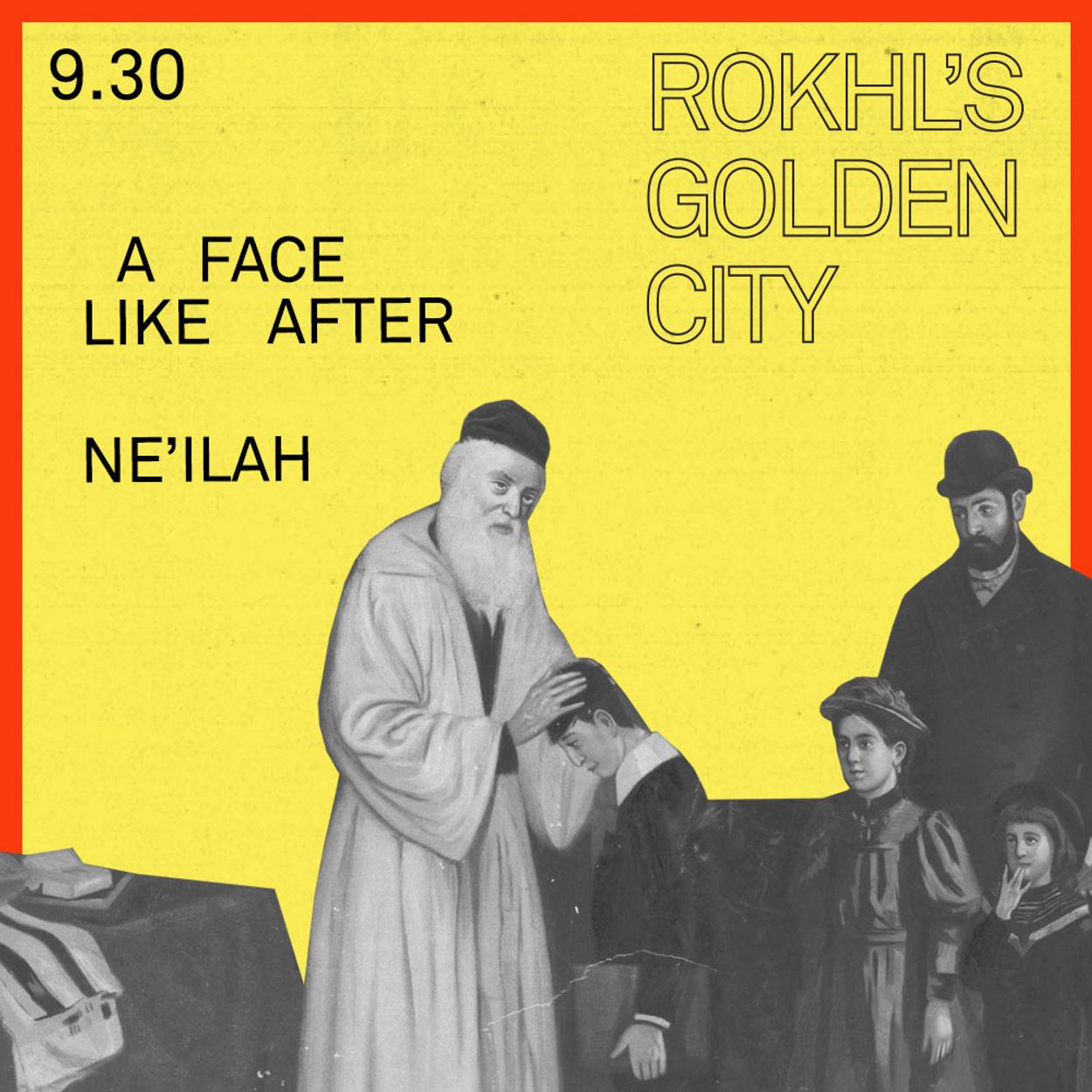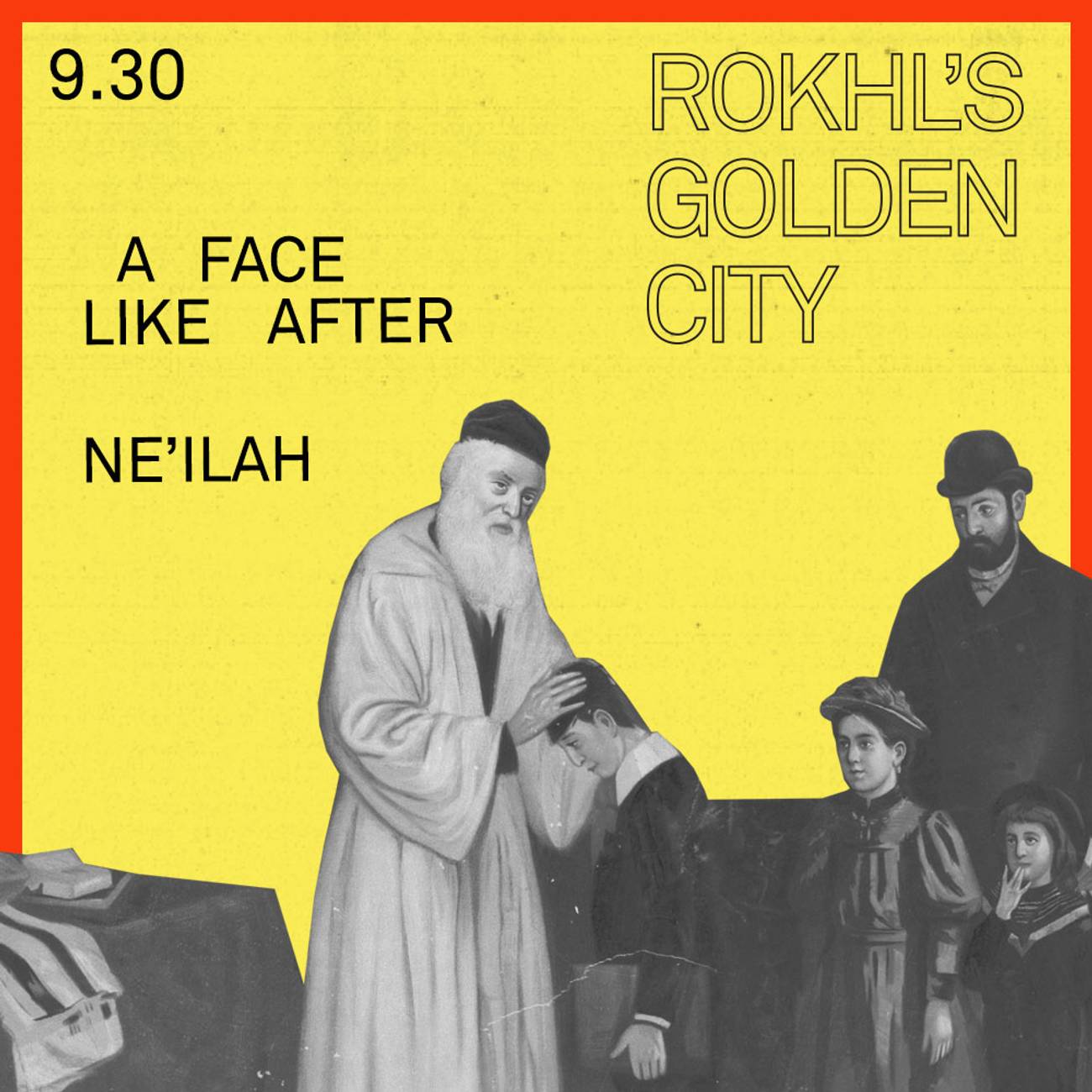‘It’s Burning,’ Again
Rokhl’s Golden City: Why Yiddish black metal is the perfect music for Yom Kippur




I want to talk about Yom Kippur. But only because I’m dreading it. The best part of Yom Kippur is nile, or Ne’ilah, if you prefer. The gates of heaven are closing. The shoyfer is blowing. Maybe someone is even going into the shul kitchen to bring out a tray with little cups of apple juice. You feel elated. But let’s be real, you look like hell. I mean, I do. You probably look fresh as a daisy.
After 25-ish hours of fasting and repenting for all your sins, you probably don’t want to think about your own mortal weakness for a while, if not a whole year. The contrast between those feelings—pre-repentance and post-repentance—is the subject of Aaron Lebedeff’s superb comic Yiddish theater song, “Far nile, nokh nile” (Before Nile, After Nile).
far nile, nokh nile (before nile, after nile)
a bokher, a bsile (whether a boy or a girl)
darf a yeyder zayn a shtikl mentsh (every person must strive to be a mentsh)
So far, so good. Practical, if bland, moral advice. The song continues: In each of our lifetimes we must make a kheshbn. Kheshbn is a loshn-koydesh (Hebrew-Aramaic) word meaning accounting. It has a very specific meaning in relation to Rosh Hashanah and Yom Kippur. Traditionally, one makes an accounting of the soul, a kheshbn hanefesh, in preparation for judgment. And Hashem is doing his own accounting in order to seal us, hopefully, in the Book of Life. So, says Lebedeff, don’t be too snobbish. Down the road, fate may leave you, too, with a face looking like “after nile.”
And the girls. The girls! Today’s girls, he says, smear mascara on their eyes to look good for the boys. But in the morning, when they see themselves:
hobn zey a ponim vi nokh nile (they have a face like the one after nile)
un derfar zog ikh (therefore I say)
un gedenkt dos git bay zikh (and you should remember it well, too …)
Living in the age of front-facing cameras and social media, we tend to think we’re the first to be obsessed with our own images, and specifically, the suspicion that good looks reflect inner goodness. But Lebedeff gets his jabs in at the vanity of his own generation, with special attention, of course, to the girls. The message is reminiscent of memento mori paintings. Memento mori is Latin for “remember you must die.” Such a painting might be a portrait with symbols of mortality—a skull or hourglass, for example. In Lebedeff’s song, the haggard, post-nile face is sort of like the skull in the painting, whispering of what we mustn’t forget.
In their section on the memento mori painting, the Tate London Museum says they “became popular in the 17th century, in a religious age when almost everyone believed that life on earth was merely a preparation for an afterlife.” Of course, traditional Eastern European Jews also believed that they were preparing for the world to come, after death. But for Lebedeff, the emphasis is on one’s behavior in the here and now. And traditional Jewish life in Eastern Europe placed great value on this life, and its ethical cultivation. Whether it’s minutes before nile, or hours later, when the previous day’s bodily abnegations have been forgotten, what matters is being a mentsh.
Lebedeff’s message, while serious, is presented in his delightfully lighthearted, song-and-dance-man style. If that’s not quite doing it for you in terms of musical musar, have you considered Yiddish black metal?
I was scrolling (I know, Lebedeff would mock me) Instagram when I came across the band Akloleh, which in Yiddish means “a curse.” Unlike my own page—dozens of only slightly different glamour shots taken in front of the same grimy window—Akloleh’s Instagram aesthetic is entirely “haunted forest,” with barely a human figure to be found.
Akloleh is made up of one man in particular, who goes by the stage name Mazik, which he asked to be used for this article. In publicity, he describes his project like this: “Akloleh is based deep within the Alaskan rainforest, amid glaciers and towering mountains. With furious guitars and desperate screams, Akloleh uses the Tanakh and other Jewish texts to make sense of environmental devastation, antisemitism, exploitation, and rampant greed.” Is there anything more appropriate for Yom Kippur 2022 than a new black metal liturgy?
The band’s first album, A Curse, came out last year and used mostly biblical texts. The second album, Eternal Ritual, comes out this fall, and the first single is one of the most beloved, and most recorded, Yiddish songs, from the catalog of Mordechai Gebirtig.
Whether you’re ready for it or not, you should hear Akloleh’s setting of Gebirtig’s “Es Brent” (It’s Burning).
Written in the late 1930s in Krakow, Poland, there was nothing metaphorical about the fire Gebirtig described. These were Jewish homes and towns going up in flames. I got in touch with Mazik to find out more. Why record “Es Brent”? As he told me in an email: “The first recording I heard of this song was this intense, urgent version that had instrumentation like sirens, fast strumming, and the singing sounded so desperate. And the lyrics themselves have felt more and more relevant the older I’ve gotten as antisemitism has been rising around the U.S.”
Despite the events being almost a century distant from us, the song’s power, and what it describes, continues to reach new generations. Mazik described frustration at what he perceived to be indifference to antisemitism among his circle of friends. Even among the progressive and accepting, he saw a “stunning silence” in respect to antisemitic violence:
“I kept thinking of Mordechai Gebirtig’s lyrics and was wondering how I could capture the same intensity” of that first recording he had heard. “So I came up with this kind of punchy riff that’s the main focus of the song. I wanted to really capture that whole range of feelings—frustration, desperation, depression, isolation, but also resilience and defiance.”
For Mazik, the song reverberates with multiple interpretations. One is quite literal. Before coming to Alaska, he lived in California, where smoke and ash from wildfires regularly made it impossible to go outside without an N95 mask. “I have a feeling of looking around and asking others, ‘are we just going to watch this fire burn?’” He makes a point of not blaming individual consumers for a phenomenon driven by global corporations, but says that the song “is also a call for us to reflect on our culpability in systemic violence that includes climate change; for all of us to ask how we have participated in and maybe enabled climate change, racism, and economic inequity.”
The first album used mostly Hebrew texts, especially selections from Ezekiel and Lamentations. Those texts spoke to the environmental anxiety he was feeling, sparked by California’s devastating wildfires, and the realization that such devastation was no longer the exception, but the new normal. For the second album, though, he wanted to do something different. He set out to make a black metal album “rooted in Ashkenazi culture to some extent” and exploring “more typical black metal topics like magic, ritual, and hopelessness.” Despite never having owned a black metal album in my life, you can imagine me clicking the “purchase” button immediately.
I always had a vague notion that black metal was fatally contaminated by its association with antisemitism and Swedish church burnings. Not exactly fertile ground for Yiddish fusion. But Mazik told me labels and bands are refusing to work with anyone associated with National Socialist black metal (NSBM) and, as someone who clearly loves the scene, pushing back on the antisemitism was part of the reason he wanted to start a Jewish black metal band in the first place. Tshuve.
But aside from the antisemitism, I’m not really sure how one listens to black metal. Mazik, a black metal fan from the age of 15, says he finds it meditative, “especially with the excessive reverb and tremolo-picked riffs that feel almost symphonic when your ear adjusts.The intensity kind of takes me to another place that feels very freeing and expressive.”
I’m not sure my rapidly aging ear could ever really adjust to the black metal ethos. But I find Mazik’s project fascinating. His story is not just one of unexpected fusions, but also return, tshuve. He had grown up going to temple “semi-regularly” with his mother, but drifted away from Jewish life at 15. At the age of 19, he discovered his father’s hidden Jewish heritage, learning that his grandfather had been a Yiddish-speaking Jew from Eastern Europe. It was that discovery that drew him to learning Yiddish, combining Duolingo with reading Yiddish poetry. And now it is 2022, and as “Mazik” he is a Jewish musician making unlikely Yiddish music from ek velt, the edge of the world.
The shoyfer blasts of this season are meant to wake us up spiritually, and no doubt somatically, too. Wake up! they say. No more looking away, from ourselves or the world. On Yom Kippur we read the book of Jonah, a reluctant prophet whose story famously begins with God telling him to wake the hell up and get to Nineveh. In Akloleh’s percussive riffs I find echoes of the shoyfer’s blast. This is music for the season, which insists on itself, music which would wake even the sleepiest of prophets.
ALSO: The Cantors Assembly presents a Moyshe Oisher Virtual Film Festival, opening Oct. 2 and running through April 2023. More information here … Now up at the American Jewish Historical Society, a new exhibit on the history of Union Square, site of so much Yiddish labor history: From Sitting Room to Soapbox: Emma Lazarus, Union Square, & American Identity. In conjunction with the exhibit, AJHS will host a daylong symposium on Oct. 2 called “Jews in the Gilded Age.” … On Oct. 27, the Yiddish Book Center and Posen Library of Jewish Culture and Civilization will present “Women’s roles across literature, culture, and the rise of feminism: 1973–2005,” a talk by Deborah Dash Moore. Register here … Jewish Studies at Fordham has offered its walking tour of the Jewish Bronx with Julian Voloj a couple times now, but it seems to sell out immediately. So even if you can’t go on the walk in person, you can check out Julian Voloj’s talk on YouTube today … I see from my Klezkanada friend Jason Rosenblatt that the Jerusalem Harmonica Festival will be happening Nov. 16-17. Jason is an amazing harmonica player, and yes, klezmer harmonica is a thing you need to know about. Save the date!
Rokhl Kafrissen is a New York-based cultural critic and playwright.